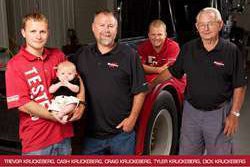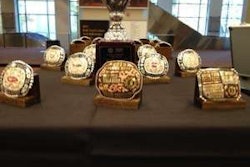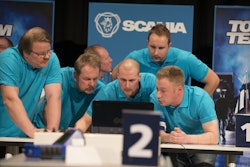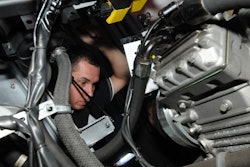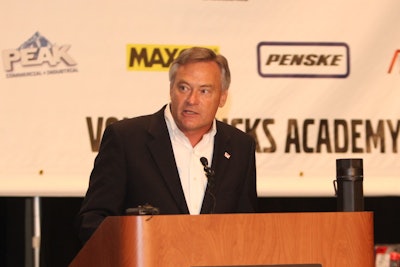 Guest Blog: Mike Delaney, president and CEO of WheelTime Network
Guest Blog: Mike Delaney, president and CEO of WheelTime NetworkIntense competition pushes everything to the outer limits of what we think is possible. Most techs in the room know this competition is intense – but, is SuperTech pushing us to the limits? Is it helping to reset the boundaries of what we’ve come to expect from our best practices and productivity in the shop?
To find out, we interviewed some training leaders that have been sending teams to SuperTech for years. We figured SuperTech was positive or they wouldn’t keep coming back. But what exactly does it mean to them? Has SuperTech changed them in any way – making them better trainers or companies?
I wish I could tell you who they are but I promised I wouldn’t. What I can say is they are incredibly dedicated people. Their performance here speaks volumes. And … they cheer really loud.
Our interviews focused around two main questions:
- How has SuperTech impacted the way you train and develop technicians?
- What business results can you attribute directly to your SuperTech efforts?
My first interviewee told me his team is picked straight from results achieved in their everyday training and certification process – a process that follows the same ASE certification basis as SuperTech. But it doesn’t stop there. Their top techs help train and mentor other techs, and they also help to design new training modules.
He defines the best team as one where each member can do anything. Broad skill sets make his techs capable of working independently, but they can also assist others in trouble. Everyone must be prepared to be the leader at any time. He believes that people who win at SuperTech have a broad range of skills, and are better prepared to be true leaders in the future.
But how has it worked at the business level? Are they getting results that improve the overall business?
Well, at their shops, comebacks – trucks that didn’t get fixed right the first time – run about half the industry average. They also see that rejected warranty claims, which use to run close to ¾ of a million dollars annually, have dropped by 87 percent. Productivity is up, and shop throughput is up – because the time to fix things has been significantly reduced. The result? Units out of service are down 20 percent – no small feat with many thousands of vehicles rolling.
We heard some of the same comments from the next training leader, who said, “SuperTech has made us better as a company. It inspired us to invest more in training, and to focus on better ways to train and develop people.” In fact, their training budget has risen over 100 percent since they started, but it’s an investment that has already paid great dividends. He told me “It has gained the attention of the company’s top management – they have connected the dots between training and Return on Investment”.
That ROI has been demonstrated in a number of ways. Techs are getting a lot more work done in the same time – as much as 30 percent more among their top techs, such as the ones here today. But their costs have dropped as well. Come-backs have fallen significantly. They’ve reduced warranty claims. And customer satisfaction has increased. In fact, several large national accounts specifically cite their focus on developing ASE master techs, and their SuperTech involvement, as things that separate them from their competition.
My third interview was with a large organization that has been very successful here at SuperTech. But it wasn’t always that way. He said, “In the beginning, we thought we were pretty good, but we got our tails handed to us in our first event.” No wins in any categories – nobody in the top ten. Instead of accepting this as failure, they turned it into a learning experience, and put their heads together to draw some conclusions about what they wanted to do about it.
They decided that ASE mattered. They decided that competitions mattered too, and to support their techs at local and regional events. And they decided to invest in helping techs train by giving them the materials, time, and tools they needed.
But all of this required investment – and backing from senior management. So they proposed a three year test. They would use ASE based training and certification as the core, leveraging SuperTech and other competitions to drive focus. They got their approval, but with a string attached: they had to develop a 5 year projection on hard returns generated by the new program, and be accountable for achieving them.
Well it worked far better than anyone had predicted. They blew out the five year ROI projections in the first three years, at which point everyone was on board. That opened the door to more training dollars, and gave them more latitude to support even more competitive activity.
They tracked significant drops in parts costs, breakdowns and rework. Productivity was up, and so was employee satisfaction. Employee turnover dropped. And more benefits emerged, sometimes unexpectedly. When they attended a meeting of over 60 fleets to hear about CSA scoring, they were surprised to learn that they had the lowest scores of any fleet in the room – by double digits.
“Prior to SuperTech,” I was told, “we thought we had pretty good training. Afterwards, we changed everything. SuperTech gave us validation and performance beyond our typical scope – real measures.”
My last interview confirmed everything we had already heard. But that in itself it was extraordinary. This company was able to achieve similar results, across a vast organization, using the same basic tools and measures. And as with the others, competitive involvement at SuperTech has accelerated the process.
Re-work from their best trained techs – the kind represented in this room – has dropped 10% or more, and they’ve also tracked 20 percent to 25 percent lower parts consumption.
This last service leader shared some observations on why tech training and development are especially critical today. He reminded me that between 2004 and 2010 we saw new engines with EGR, DPF and SCR add-ons. For the Cummins ISX alone, that meant over 800 new fault codes, each of which could have 6 to 8 solutions. And that’s just one engine – one component.
Historical approaches aren’t enough when technology is changing as fast as it is now. To maintain productivity we’ll have to up our game in diagnostics, repair, and our methods for developing people.
The kind of training it takes to win here.
From SuperTech, we see a pattern of both standard methods and predictable results that has emerged beyond the competition. A formula has been revealed that anyone can follow, delivering results that anyone can duplicate.
A lot of smart people come together to make SuperTech happen. The funny thing is, most initially had no idea how powerful it would become as a ‘change driver.’ SuperTech is definitely about “celebrating technical excellence”. But it’s become more. Through this competition, we have data that sheds a whole new light on where to focus our efforts to create the most impact. We have reliable training methods that deliver measurable returns.
Winning at SuperTech today means diagnosing more complexity, more accurately and more quickly than ever before. It means knowing – not thinking – that your trucks won’t come back. And it means taking team-based leadership to new professional levels to guide the next generation of techs.
Ten years after inception, SuperTech is changing the way companies are doing business. I don’t think anyone we interviewed ever thought of themselves as pioneers. They could see their own progress, but I don’t think it had ever occurred to them that they have been helping to elevate an entire profession.
And it’s you techs in the room that are driving that change. With each competition you raise the bar.
So to all of you who have worked hard to make SuperTech what it is today, to all of you professionals who participate as competitors, and to all of you who have pioneered ways to drive the spirit and professionalism of SuperTech into organizations all over North America, thank you – for changing everything.


